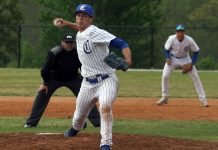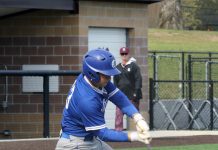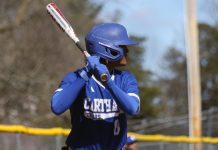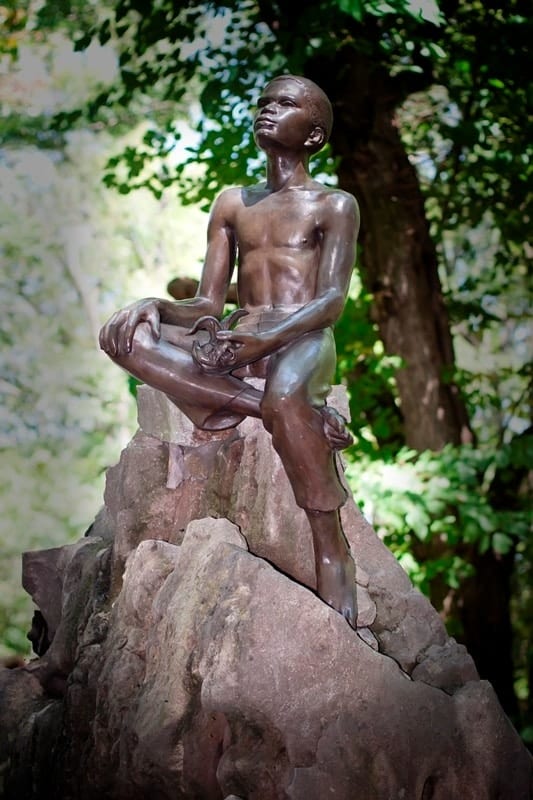Sunday, our only day off from our day jobs, is for painting, but first we walk. We being my husband David and I and our two puppies. We all flourish in the outdoors. We all love trails that go up and down and have pretty views and vistas and a waterway, too. We love walking in every season. Walking out-of-doors is our greatest shared resource for inspiration to prepare us for our Sunday studio afternoons.
Occasionally we stay in town, walk two blocks from our old house and stroll past the Andrew Carnegie Carthage Public Library admiring the Alice in Wonderland bronze created by Bill Snow and placed in the garden lined with benches supported by stone bunnies. Continuing on we circle the beautiful Carthage Central Park with the lovely cascading fountain in the curving reflecting pond and the vintage bandstand—both crafted with Carthage marble.
In the park we always admire one of Carthage’s most famous citizens, Marlin Perkins—Director of the New York Zoological Gardens in Buffalo, chief zoologist for Edmund Hillary’s 1960 expedition to Mt. Everest and a pioneering television personality with his wildlife documentaries. Artists Bob Tommey and Bill Snow have honored Marlin Perkins in a monumentally sculpted bronze crouching above the park’s spreading, lush lawn.
More alluring lawns and other easy, art-inspiring walks are to be found just outside Carthage. Enjoying the misty sprays rising high above the embankments, sometimes we take a turn around Kellogg Lake or beside the Spring River meandering past. Here we find ducks and geese flying in and hanging out, fisher people wetting their hooks from boats and banks, picnickers gathered at old cement tables and energetic Frisbee golfers playing the course.
Further west in Joplin when we chose a Sunday walk following a stretch along Shoal Creek running through Wildcat Glades, we shared the path with two friendly riders on very big mules. A few weeks later we hiked the gently hilly terrain of the Frisco Trail following Baker’s Branch where we saw well-gnawed, beautifully textured tree trunks—the workmanship of beavers diligently trimming their teeth high above the bluff-lined creekside. By the time of our return a Sunday later the crafty wood-workers had completed the felling of the tree we saw standing just the week before.
Near Diamond, Missouri, is our favorite of all our Sunday walks—discovered when our friends B and K, dedicated outdoor adventurers, responded to our question, “Do you know of nearby pretty walks with water and interesting sights where we can take our puppies?” “Oh, yes!” was their enthusiastic response, George Washington Carver Monument Park. You’ll find everything you’re looking for there!” We have!
As we wind our way out of Joplin over Reinmiller or Kodiak roads “ou-ing” and “ah-ing” at all the pastoral pleasures we survey, our excitement grows before we ever enter the wood-gated grounds. The level of exuberant barking indicates the puppies, Chiquita and Lasyrenn, think the pasture full of long horns and the garden full of goats are the best sights seen before we stop, disembark and begin to follow the paved park trail along stacked stone walls leading down into the woods.
Crossing over a lichen-encrusted board walk we always pause to admire the beautiful bronze of George Washington Carver as a boy perched high up on a giant native boulder. Continuing over a wooden bridge we check to see if we can find fishes or minnows or crawdads in the clean, clear water running beneath us. The path carries on around the contemplative pond gently winding past the home of a furry resident bank dweller we sometimes spy paddling and engraving chevrons over the still surface.
Coming to the Carvers’ small home place we like to take a rest inside and try out the two rockers set beside windows looking out over a park pasture and the creek’s oh-so-green crop of watercress growing more abundant and vibrant with each passing week. Before we reach the fieldstone enclosure around the Carver burial plot, David and Lasyrenn always have a race at the last stacked stone wall—David charging alongside as Lasyrenn runs fast, fast, fast over the top to be declared the winner more often than not. Now we’re all well exercised and nature resourced. Time to go home. Our art-making studio afternoon awaits our return. We’re ready!
We’ve learned in the introduction to the park’s website (https://www.nps.gov/gwca/index.html), George Washington Carver was “Not Just The Peanut Man. The young child known as the ‘Plant Doctor’ tended his secret garden while observing the day-to-day operations of a 19th century farm. Nature and nurture ultimately influenced George on his quest for education to becoming a renowned agricultural scientist, educator, and humanitarian.” He was also a gifted artist. In his own words Carver wrote of his art as a way to lift “souls beyond the sordid things of life, and give them a glimpse of the creator who shapes and fashions all our destinations”. Our souls are lifted each time we visit George Washington Carver Monument Park!



















